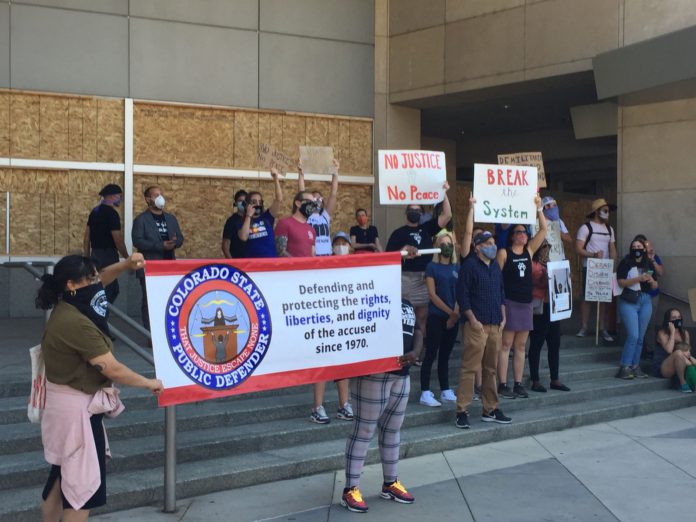
The Office of the Independent Monitor reviews all complaints involving the Denver Police Department and Denver Sheriff Department. In a normal year, it receives roughly 400 complaints, but with police brutality in the national spotlight, the office reported receiving roughly 250 over the past two weeks, according to Independent Monitor Nick Mitchell. With possible budget cuts on the horizon and increased requests from the city, the OIM is faced with large investigations, long hours and a busy year.
His organization is tasked with reviewing civilian and internal complaints against officers across the Denver Police Department and Denver Sheriff Department. There have been discussions at government levels to implement such an organization to review law enforcement across the state.
“It’s important to talk about the why,” Mitchell said. “It’s checks and balances in government. As a society, we invest police officers with a tremendous amount of power — the power to take life when necessary, power to take property, power to deprive a person of their liberty — and with that incredible power … it’s incredibly important that there are checks and balances to make sure it’s being exercised appropriately. And that’s where we come in.”
The OIM was asked by the Denver City Council recently to launch a full investigation into the DPD’s response to the George Floyd protests. In a letter of response, Mitchell noted that the office was asked to evaluate the DPD’s use of physical force, chemical agents, riot gear, surplus military equipment and riot gear, among others, and the handling of community complaints regarding alleged misconduct during the demonstrations.
The answer: “We accept.”
This request came as the DPD implemented policy changes to use of force and body cameras. In a June 7 press release, the DPD announced three “significant” changes to its practices. The DPD no longer allows, without any exceptions, chokeholds or “carotid compression technique” and officers need to report to a supervisor if they intentionally point a firearm at any person — a move designed to improve data collection and evaluation on these incidents — and the DPD Metro/SWAT unit “will activate their body-worn cameras when executing tactical operations.”
“We will continue to evaluate our policies with community input and make improvements as needed in the interest of public and officer safety,” said Chief of Police Paul Pazen.
According to Denverite, when protests started in support of removing officers involved in George Floyd’s death, the activities closed down I-25. Law enforcement responded in normal uniforms, but after an officer was struck with a rock, riot-gear and tear gas were deployed.
Mitchell noted in his response letter that given the length of the demonstrations in Denver, conducting the investigation will require reviewing hundreds “if not thousands” of hours of camera footage, radio transmissions and community video as well as digesting large volumes of documentary evidence and command staff, line officer and community member interviews.
“While I expect the investigation to be time- and labor-intensive, I assure you that our small staff will move expeditiously, and we have already drafted our first request for documents and information, which we will issue to the DPD shortly,” Mitchell wrote.
Mitchell said he expects many of the 250 recent complaints associated with the protests are duplicates, but yet, “our workload has kind of skyrocketed.” We exist in a time of declining faith in government, he said, adding the effects could be seen everywhere.
“When people feel the sense their voice matters, that making an outcry can lead to something meaningful, that they can be treated fairly — that their voice will be heard — that’s a good thing,” Mitchell said.
When seeing reporting numbers go up, he added he was encouraged that people believe in the system enough to access it when they feel they have been mistreated.
“One of our challenges is to figure out how to continue with a high level of oversight … while we’re inundated with the work associated with the George Floyd protests,” Mitchells said. The office is navigating how to perform both tasks.
For 2020, Mitchell said a large challenge for the OIM was the work that exists “separate and apart” from the activities surrounding the protests.
Body-worn cameras have become a “huge boon” to the OIM work, and have tremendous value, he said. However, as one could guess, sometimes the amount of information provided by the cameras is voluminous. At times, an investigation will include 10-15 officers on a scene all recording with body-worn cameras, and in turn expanded the amount of material to sift through to make an assessment on whether or not an incident occurred, Mitchell said.
Mitchell also expressed support for House Bill 217, which would require all law enforcement agencies to issue body-worn cameras to all officers and requires officers to activate the cameras at any time when interacting with the public.
While there may be kinks needing to be ironed out in the legislative process, there was no doubt to Mitchell that when a controversial incident takes place that footage needs to be available “sooner rather than later.”
The bill also includes a requirement that the footage be released to the public within 14 days.
The “old way” of holding on to footage until an investigation was finished, could take months, Mitchell said. “There’s a community need, a public need, for transparency associated with controversial officer-involved shootings and deaths in custody,” Mitchell said.
However, Mitchell said he was also an investigator — and wanted to get individuals’ “native recollection of the incident” and uninfluenced account by seeing the body-worn camera footage.
The OIM has gained recognition around the country for its work. Just in the past few months, mayors, officials and law enforcement from several major U.S. cities and organizations like the American Bar Association, have asked the office for guidance, advice, to sit on committees and provide testimony.
— Avery Martinez

